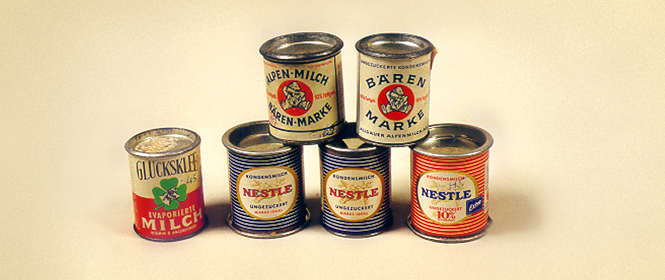
ADVERTISING DURING THE GERMAN ECONOMIC MIRACLE
Although advertising had already been widespread in 1920s Germany, it underwent a major revival during the economic miracle – all thanks to a new medium. On 3 November 1956, the first commercial was broadcast on German television. Today, these early commercials are fascinating historical documents that tell us a great deal about stereotypes and identity in the emerging nation of West Germany.
It’s eleven years since the end of the Second World War and West Germany is probably more prosperous than it has ever been. The economy is booming, wages are rising and people’s pantries and fridges are full again after years of hardship. The horrors of the Nazi regime have receded into the distance and are hardly ever the subject of public debate. In other words, the ‘Wirtschaftswunder’ (‘economic miracle’) has brought prosperity and a carefree attitude to post-war West Germany. This supposedly brave new world was accompanied by a renewed surge in consumer confidence. People were happy to treat themselves, spending their shiny new Deutschmarks on consumer goods, household items and cars.
THE ADVERTISING INDUSTRY DISCOVERS TV
This shopping frenzy was orchestrated by the newly formed advertising industry. Advertising agencies wanted to get Germans even more excited about the benefits of new products – and boost consumer demand even more. In order to achieve their aim, advertisers harnessed the power of a new medium that was able to bring Germans face to face with new products in the comfort of their living rooms. The momentous day came on 3 November 1956: the first commercial on German TV was aired on Bavarian channel Bayerischer Rundfunk – a 55-second clip promoting detergent brand Persil. It’s simple slogan: ‘Persil und nichts anderes!’ (‘Persil and nothing else!’).
The married couple, played by Beppo Brem and Liesl Karlstadt, perfectly encapsulate the carefree attitude of early West Germany. Thanks to the economic upswing, this average couple can dine in a fine restaurant, with the problems in their lives mere trifles. When a stain on the tablecloth threatens to dampen the atmosphere, Persil saves the day – and restores wedded bliss.
COMMERCIALS REFLECT THE PERCEPTION OF WOMEN
In the 1950s, many commercials played on people’s ideas of a happy marriage. TV ads for the Frauengold brand, for instance, reflected contemporary notions of married life and the role of women. Launched in 1953 as a supposedly miraculous tonic for housewives, its advertising is evidence of the patriarchal nature of society at the time. The message was that housewives should always avoid conflict with their boss or husband and, instead, drink a hearty shot of Frauengold – before reaffirming the man in his dominant role. The soothing effect of Frauengold had less to do with the secret recipe and more to do with the 16 per cent alcohol content. This was apparently designed to make women forget the fact that they usually had very little say in the early years of West Germany.
MINI ‘HEIMATFILME’ (‘FOLK FILMS’)
1950s German society was searching for peace, security and prosperity, with people wanting to put the harrowing war years as far behind them as possible. This trend was reflected in ‘Heimatfilme’, which portrayed a naive and unspoilt world where all was well. This carried over to advertising, with the commercials for food and drink brand Bärenmarke constituting mini folk films. They satisfied the German need for harmonious country life and picture-perfect Alpine backdrops. They also gave rise to one of the first advertising characters who is still known today – a little bear who it is said delivers the delicious Bärenmarke products.
CHARACTERS GIVE PRODUCTS A FACE
The benefit of advertising characters was clear for all to see: they made the products recognisable and boosted the popularity of the brands. From the 1960s onwards, in particular, this point was proven by Meister Proper, the Haribo Gold-Bear and Frau Antje. Another character – created back in the 1950s – still enjoys cult status in Germany. The funny thing is that he represents a product that hasn’t been advertised on German TV since 1974 – but that was largely consumed without thinking back in those days.
‘HB-MÄNNCHEN’ (‘HB MAN’) MORE FAMOUS THAN THE GERMAN CHANCELLOR
In the 1960s, 96 per cent of West Germans had heard of HB Man Bruno, making him a more recognisable figure than the Chancellor of the day. The slogan ‘Wer wird denn gleich in die Luft gehen?’ (which roughly translates as ‘Is someone about to hit the roof?’) passed into everyday usage. Just a decade after hitting the airwaves, the commercial achieved an important aim: placing products with which the consumer could fully identify. This only worked because the commercial took its cue from the zeitgeist in every way, reproducing its recognisable characters countless times. In this regard, today’s adverts are no different.